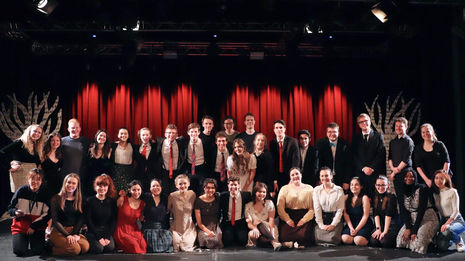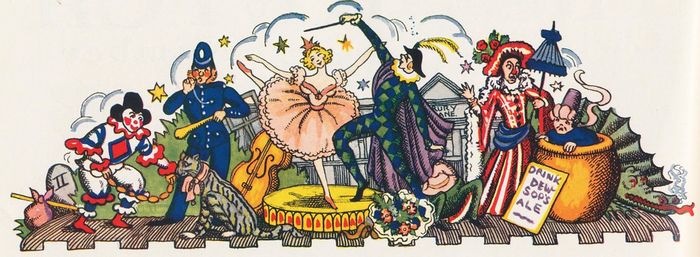Why angsty teenagers + rock = success
Charmaine Au-Yeung discusses what makes Spring Awakening an enduring hit

CN: This article contains references to abuse and sex in theatrical productions.
Objectively-speaking, it’s totally f*cked that a censored 1891 German play about sex would a.) be adapted into a musical, and b.) actually become a classic hit. Centred around a group of children at the precipice of adulthood, the musical does not shy away from heavy themes. Wendla, a young girl confused by her own growing body, starts off the musical proclaiming that her mother gave her ‘no way to handle things’ - including a straight answer about where babies come from. Her mother’s unwillingness to tell all leaves her vulnerable, particularly at the hands of Melchior, a boy frustrated by his school’s conservative values. Melchior’s best friend, Moritz, struggles with nightmares of a woman’s legs, and his ‘deepening conviction that some dark part of his destiny may lie there between them’; when he is propositioned by an old childhood friend, Ilse, it only causes him more angst. Ilse, and another friend, Martha, are abused and betrayed by their parents, the people who should be there for them.
Spring Awakening’s rock score certainly does its job of expressing the angsty cries of a generation frustrated with their parents. Electric guitars are the background to belty, angry numbers, like ‘Mama Who Bore Me’ and ‘The B***h of Living’, but fade into the shadows with weepy strings and piano in dark and impactful moments for the characters, including ‘The Dark I Know Well’ and ‘Those You’ve Known’. The music, cleverly written by Duncan Sheik and Steven Slater, doesn’t just consist of toe-tappy, satisfying-to-belt numbers that do the rounds in musical theatre karaoke nights (been there), it also made big stars out of the then-teenage cast. Lea Michele went on to find fame in Glee; Jonathan Groff on television and in numerous other Broadway productions, including Hamilton; Lili Cooper in Spongebob; and, of course, John Gallagher Jr. with the Tony Award for Best Supporting Actor in a Musical. 15 years on, and Spring Awakening remains as popular as ever; now well into their thirties, the original Broadway cast held a one-night-only reunion last November and, of course, it sold out.
“It blew my mind to find a musical about people my age asking adults to cut the crap”
This popularity extends beyond professional theatre, with Spring Awakening also regularly making waves in amateur theatre circles, including mine. I played Ilse in St Andrews in March 2020, the week before lockdown was announced. Whilst reading news of a growing global crisis backstage put a damper on things, being in the production was still something like a dream come true – and, quite frankly, it was cathartic to jump around stage screaming that we were all ‘Totally F*cked’.
Growing up, I was always a big theatre kid; but when I first listened to Spring Awakening’s cast recording in Year 10, it blew my mind to find a musical about people my age asking adults to cut the crap. It certainly subverts the image of musicals as happy escapism. Indeed, it’s so beloved because of its dark themes, its timelessness, and its ability to speak to the present even though its original story was written more than a century ago.
“Whilst the musical can be depressing, there is hope at the end”
Spring Awakening is the ideal sandbox musical. The original Broadway set was deliberately designed to look fairly barebones, both to encourage other productions to make the musical their own and to allow the musical to speak to multiple social issues, past and present, including ones not touched on by the original.
The Deaf West production on Broadway, for example, emphasises the distinction between hearing and non-hearing individuals through the miscommunications the actors have in the plot. The new production at the Almeida in London also brings in references to XR and BLM; hearing the actors sing ‘blah blah blah’ hearkens back to Greta Thunberg’s speech at COP26. In the production I was involved in, our directors gave us shirts to wear for the final number, ‘Song of Purple Summer’, emblazoned with the logos of mental health charities. Their rationale was whilst the musical can be depressing, there is hope at the end. The characters have learned a lot, and will go on to better each other in the places where their parents failed them. That message of hope, even in spite of the darkness, is something that sticks.
 News / Newnham postgrads referred to homeless charities as College runs out of rooms31 July 2025
News / Newnham postgrads referred to homeless charities as College runs out of rooms31 July 2025 Features / Selling the Cambridge experience: private summer programmes in the historic university 3 August 2025
Features / Selling the Cambridge experience: private summer programmes in the historic university 3 August 2025 News / News in Brief: Bare bikers, business and budding scientists3 August 2025
News / News in Brief: Bare bikers, business and budding scientists3 August 2025 News / Two arrested after death of Cambridge language school student 4 August 2025
News / Two arrested after death of Cambridge language school student 4 August 2025 Interviews / A place to Thrive: Cambridge’s all-vegan café and community hub3 August 2025
Interviews / A place to Thrive: Cambridge’s all-vegan café and community hub3 August 2025









